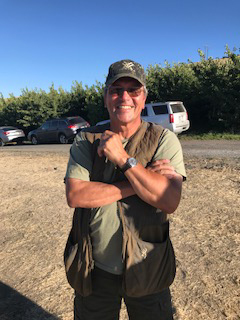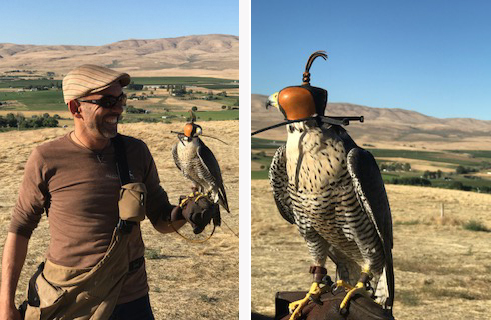The name “starling” is disarmingly cute, and of course it’s fun to say aloud. Does the final syllable rhyme with ring, or do we drop the g and turn it into lean? Starling. Starlean. Starline. Starling(guh). I’m told it’s a matter of whether one favors a velar or alveolar nasal consonant.
Okay, maybe I have an odd sense of what’s fun.
All things considered I prefer calling the bird by its binomial nomenclature, which really should be a recurring character on Game of Thrones: Sturnus Vulgaris.
There are roughly a billion starlings in North America. They are what is politely referred to as a “problem bird.” They chase away our native nesters like bluebirds and woodpeckers, their excrement broadcasts invasive seeds and disease, and their song is a derivative gargle of half-throated love ballads and smug booty calls. Even how they got to America is annoying – they were smuggled into New York from Europe by a pharmaceutical manufacturer. The reason? Turns out this fellow, Eugene Schieffelin, was a huge Shakespeare fan, and he wanted all of the birds noted in The Bard’s works to be able to harmonize together in our brave new country. (If you were wondering, the starling is one of more than 600 avian species mentioned Shakespeare, and it debuts in Henry IV, Part 1). It may not be the worst idea in the history of the arts but it’s got to be in the discussion.
Since their debut in in Central Park the starling has been pretty much universally reviled. You may be surprised to learn that even my friends at the Audubon Society say it’s okay to hate certain birds; but you’ll be relieved to know they heartily recommend you start with starlings.
So if you hate starlings, you’re going to love falcons. And if you love falcons, then I hope one day you get to meet a Master falconer named Vahe’ Alaverdian.
The man is handsome, funny, and he trains falcons to absolutely murder starlings. (Trigger warning: the falcons also snack on the common house finch, and I could sugar coat it by saying that they devour large quantities of Turdus Migratorius, but you’d just google it and figure out I was talking about robins).
Vahe’ was born in Armenia and grew up in Los Angeles. Vahe studied photography and for a time ran successful photography studio, but his lifelong passion for the sport of falconry eventually became irresistible. So Vahe’ founded Falcon Force, a Wyoming-based company that trains raptors to “abate” problem birds around the United States. Are the seagulls bothering the tourists? No problem. The geese are mucking up your golf course? Vahe’s got you covered. Pigeons, sparrows, ravens (ravens!?) or magpies? If any of these pests is causing a ruckus at your vineyard, racetrack, airport or theme park, then Falcon Force will put together what amounts to a Seal Team 6 of raptors to abate the nuisance. Falcon Force currently has a stable of 43 raptors and are performing a variety of abatement contracts in six western states.
Vahe’ and his Falcon Force colleague Kalen Pearson came to the Yakima Valley in June of this year and stayed into August. Kalen grew up in La Connor, Washington, and her love of animals (with the notable exception of starlings) is contagious. She trained horses as a young teenager and soon was working with wolves, zebras, camels and emus, finally settling into a career as a professional falconer in her early twenties.
Vahe’ and Kalen were in the Valley at the invitation of Roy Farms, out in Moxee, Washington, which was looking for an innovative and environmentally responsible way to control the rampant damage that starlings and other problem birds were causing to its blueberry and cherry crops.
Roy Farms has embraced environmental stewardship as one of its core business values, and it has branded its approach as “soft farming”. The company believes that the best way to produce exceptional agricultural commodities is to allow the plants to thrive in a healthy ecosystem. (If you’re interested, check out their sustainability report. Very cool). I’ve always been a casual fan of sustainable farming practices for predictable and commonly harbored reasons, but I’m become a full-fledged convert now that I know it involves reminding starlings of exactly where they belong in the food chain.

The falcon program at Roy Farms is managed by Mark Flamm. Mark is not a guy you’d describe as giddy, but his face lights up like a kid every time the falcons whiz past. Mark first hired Falcon Force in 2010. Vahe’ has been coming up every year since, and as he’s learned more about the local terrain, the local crops, and bird populations, he’s been able to work with Mark to tailor his approach to the specific conditions here in the Valley.
The Falcon Force team turns out to be a stunningly effective solution to a simple math problem. The math problem goes like this: Starlings will regularly show up in flocks of up to 5,000. Each bird can eat 5 pounds of fruit in the weeks leading up to harvest. Consumption aside, a single peck relegates the fruit for the cull bin and an agitated wing flutter can knock ripe fruit off the tree or vine. Then add in the sporadic damage by magpies, robins and sparrows, and you’ve got a significant financial problem on your hands. Industry sources estimate that starlings alone cause more than one billion dollars in damage to US crops every year. So, how does a local farmer keep more than ten tons of fruit out of the birds’ bellies and instead shipped to market? Bring in Falcon Force and either kill, maim or scatter the thousands of birds that were fixing to feast on your profit margins.
Roy Farms recently invited local members of its fan club to a demonstration by Vahe’, Kalen, and their feathered friends. The team consisted of Peregrine, Apolomado, Barbary, Saker and Prairie falcons, and was rounded by a Harris Hawk and a Augur buzzard. They were magnificent creatures to behold. Regal even. Their names were affectionate and fun (“Shaman,” “Genghis,” “Maleficent”), but they were natural born killers, each and every one of them. It was a perfect Yakima Valley day. Brutal heat. Zero humidity. And on the soft, quiet summer breeze I swear I could smell fear. Starlings scared seedless. I couldn’t make out precisely what they were chattering about, but I’m pretty sure it translated roughly to “last shadow.”
Each raptor has its own signature hunting style. The Peregrine falcon, for example, is the fastest animal on the planet and its speed sets it apart from the others on the team. It’ll float up effortlessly on the soft thermal winds and then come screaming down to earth at speeds of over 100 mph. The kinetic energy produced by the combination of weight and speed can break the neck, mid-flight, of prey that is up to 8 times its size. Vahe’ would swing around a string that was appended by a tasty pigeon carcass (farm raised) and entice the Peregrine to zoom in for a simulated kill. More than a few of us winced as Ghengis barreled past our faces at autobahn speeds. “Just make sure you don’t flinch,” said Vahe’. “They only attack things that move.” After a successful strike of the bird meat the predators would lounge on Vahe’s leather glove and enjoy a well-deserved snack.
The Harris Hawk looks like the welter-weight version of a Golden Eagle. It’s versatile enough to herd up starlings and escort them long distances away, but it’s just as likely to airlift a moderately-sized mammal back to the lunch table on the way home. It was a little nerve-wracking, because there were a couple of toddlers in our group and I was afraid one of them sounded a little too much like a goat.
The Aplomado falcon is smaller than the Peregrine, and its smaller size and deft maneuvering allows it to give chase through the branches of the orchards where the prey would otherwise seek refuge. The Prarie falcon and Barbary falcon also bring complementary skills and traits that allow Falcon Force to deploy an array of methods and styles that eliminate virtually every angle the starlings might take to survive.
Which brings me to the Augur buzzard, which in my opinion got a raw deal from whichever taxonomist had the naming rights. Buzzard? Makes me think of turkey vultures hopping greedily toward roadkill. Not this guy. The Augur buzzard is not a scavenger, but rather is a full-on predator. Falcons eat basically one thing, and that one thing is other birds. The Augur buzzard loves to eat birds too, but is just as likely to grab snakes and small rodents. Fun fact? The live mascot at Seahawks games is actually an Augur buzzard, named Taima.
The predators at Roy Farms don’t kill all the birds, of course. But it’s fair to say that the starlings don’t stay comfortable for long in a Roy Farms blueberry patch. I’m not sure what kind of family structures or friendships are established in a given murmuration of starlings, but I’m guessing that if you see enough of your flying companions disappear into a burst of feathers and bone you’re going to start thinking about short-term migration.
Falconry has been around since about 2205 BC. That’s a lot of centuries. First reports of falconry come from China and Persia, and there are reports that Aztecs also made use of trained predators. Originally falcons were employed as a tool to catch food for the dinner table. With the advent of gunpowder, however, fewer and fewer people saw the utility of sending a chaperoned bird after supper. By 1600 the English had taken all the fun out of it, imposing new rules that restricted only folks of a certain class to fly birds of a certain breed: A king could fly a Gyrlfacon, an earl a Peregrine, and sparrowhawks were reserved for priests. Servants and Yeoman, thankfully, still qualified for Goshawks and Kestrels.
Over the past 29 years Vahe’ has traveled the world to observe and study the history and the current applications of falconry across different cultures. In addition to finely tuned abatement techniques he brings a humble fascination for the raw elegance and majesty of falconry, and his passion shines through as he talks about and demonstrates his calling. To Vahe’, Kalen and the Falcon Force team, we salute you in your dedication to an ancient art, and we thank you for bring these beautiful birds to our Valley. To Mark Flamm and our friends at Roy Farms, we applaud your commitment to sustainable agriculture, and we celebrate the way that you’ve helped reintroduce a once-gentrified practice into modern agriculture.
And to the starlings, we say: So long suckers!
Thank you, Brendan Monahan for this great story and photos, and thanks to Justo Gonzalez as well for the photos and amazing video!











Super interesting, informative, well researched and written (murmurations!). Just a little bit funny too. Wouldn’t you know the starlings came from NY. Good going “Rooted”. The piece merits a national audience…or dare I suggest the ” New Yorker “.
How do we become part of the fan club? Would love to see the demonstration next year
How do we become part of the fan club? Would love to see the demonstration next year
Very Interesting. I wonder if it is cost prohibitive for smaller companies to do this?
I agree with Pat Burke.